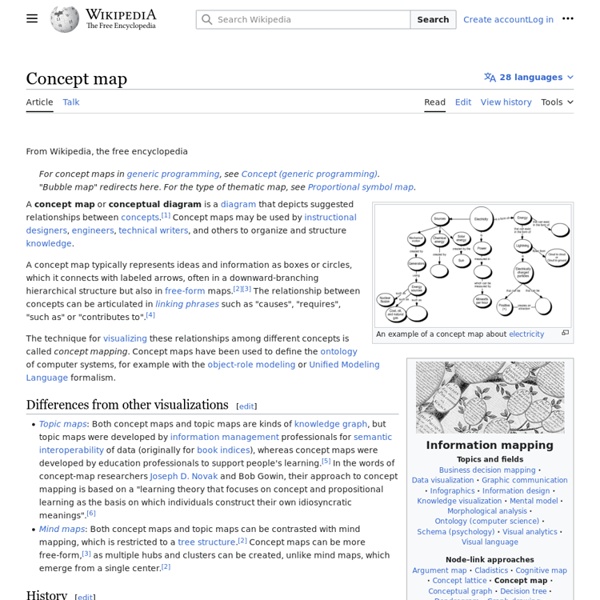Generative art
Joseph NechvatalOrgiastic abattOir,2004 computer-robotic assisted acrylic on canvas created by viral-based C++ software Installation view of Irrationnal Geometrics 2008 by Pascal Dombis Generative art refers to art that in whole or in part has been created with the use of an autonomous system. An autonomous system in this context is generally one that is non-human and can independently determine features of an artwork that would otherwise require decisions made directly by the artist.
Mind map
This article is about the diagram. For the geographical concept, see Mental mapping. Hand-drawn and computer-drawn variations of a mind map. A mind map is a diagram used to visually organize information. A mind map is often created around a single concept, drawn as an image in the center of a blank landscape page, to which associated representations of ideas such as images, words and parts of words are added.
New media
New media most commonly refers to content available on-demand through the Internet, accessible on any digital device, usually containing interactive user feedback and creative participation. Common examples of new media include websites such as online newspapers, blogs, or wikis, video games, and social media. A defining characteristic of new media is dialogue. New Media transmit content through connection and conversation. It enables people around the world to share, comment on, and discuss a wide variety of topics. Unlike any of past technologies, New Media is grounded on an interactive community.[1]
Mind42 - Mind mapping can be Free, Fast and Simple
Information art - Wikipedia
Information art (also data art or informatism) is an emerging field of electronic art that synthesizes computer science, information technology, and more classical forms of art, including performance art, visual art, new media art and conceptual art.[1] Information Art often includes interaction with computers that generate artistic content based on the processing of large amounts of data.[2] Background[edit] Kynaston McShine's "Information"
New media art
Newskool ASCII Screenshot New media art is a genre that encompasses artworks created with new media technologies, including digital art, computer graphics, computer animation, virtual art, Internet art, interactive art, video games, computer robotics, and art as biotechnology. The term differentiates itself by its resulting cultural objects and social events, which can be seen in opposition to those deriving from old visual arts (i.e. traditional painting, sculpture, etc.). This concern with medium is a key feature of much contemporary art and indeed many art schools and major Universities now offer majors in "New Genres" or "New Media"[1] and a growing number of graduate programs have emerged internationally.[2] New Media Art often involves interaction between artist and observer or between observers and the artwork, which responds to them. History[edit] In 1958 Wolf Vostell becomes the first artist who incorporates a television set into one of his works.
Systems art
Systems art is art influenced by cybernetics, and systems theory, that reflects on natural systems, social systems and social signs of the art world itself.[1] Systems art emerged as part of the first wave of the conceptual art movement extended in the 1960s and 1970s. Closely related and overlapping terms are Anti-form movement, Cybernetic art, Generative Systems, Process art, Systems aesthetic, Systemic art, Systemic painting and Systems sculptures.
Virtual art - Wikipedia
Virtual art is a term for the virtualization of art, made with the technical media developed at the end of the 1980s (or a bit before, in some cases).[1] These include human-machine interfaces such as visualization casks, stereoscopic spectacles and screens, digital painting and sculpture, generators of three-dimensional sound, data gloves, data clothes, position sensors, tactile and power feed-back systems, etc.[2] As virtual art covers such a wide array of mediums it is a catch-all term for specific focuses within it. Much contemporary art has become, in Frank Popper's terms, virtualized.[3] Definition[edit]
In-game photography - Wikipedia
For the photos of the real world taken to be used in virtual reality, see VR photography. In-game photography (also known as screenshot art, screenshot photography and professional gaming photography) is a form of new media art, which consists of photographing video game worlds. Screenshot photography has been featured in physical art galleries around the world. The validity and legality of this art form is sometimes questioned due to the fact that in-game photographers are taking photos of artwork created by the game's designers and artists.[1] However for the most part in-game photographers share the same motivations as "real life" photographers, including a desire to capture visually interesting images, preserve memories, and demonstrating technical expertise.[2] One of the earliest known works of in-game photography was Thirteen Most Beautiful Avatars by Eva and Franco Mattes.
Conway's Game of Life
"Conway game" redirects here. For Conway's surreal number game theory, see surreal number. The Game of Life, also known simply as Life, is a cellular automaton devised by the British mathematician John Horton Conway in 1970.[1] The "game" is a zero-player game, meaning that its evolution is determined by its initial state, requiring no further input.
ImageNet - Wikipedia
The ImageNet project is a large visual database designed for use in visual object recognition software research. As of 2016, over ten million URLs of images have been hand-annotated by ImageNet to indicate what objects are pictured; in at least one million of the images, bounding boxes are also provided.[1] The database of annotations of third-party image URL's is freely available directly from ImageNet; however, the actual images are not owned by ImageNet.[2] Since 2010, the ImageNet project runs an annual software contest, the ImageNet Large Scale Visual Recognition Challenge (ILSVRC), where software programs compete to correctly classify and detect objects and scenes. Dataset[edit] ImageNet crowdsources its annotation process. Image-level annotations indicate the presence or absence of an object class in an image, such as "there are tigers in this image" or "there are no tigers in this image". ImageNet Challenge[edit]



